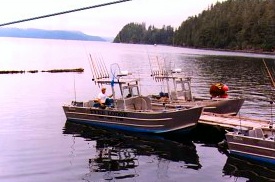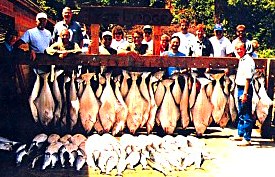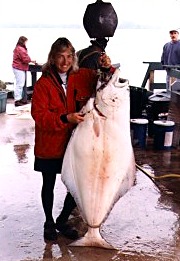|
|
|
List of BC Adventure Advertisers Site Info
Advertise With UsAwards About Us Contact Us  Kayak with Killer Whales Free Vacation Guides
BC Vacation GuidesCoastal Vacations Thompson Okanagan EcoTourism Fishing Vacations Guest Ranch Guide Romantic Getaways Wilderness Vacations Winter Vacations The Rockies Guide 
Coastal Spirits Expeditions Login |
Winter fishing at Bamfield is influenced by southeast gales and these blow directly on the leading edge Pacific shores, necessitating fishing close to the harbour mouth. Herring gather in large numbers for a February-March spawn on Barkley Sound's northern shore, particularly Vernon Bay, drawing resident feeder chinook into deep-water holding areas. Summer fishing at Bamfield is influenced by proximity to the Alberni Inlet. Large runs of sockeye from the Stamp/Somass River system and Henderson Lake and chinook from the Robertson Creek hatchery swim by Bamfield on their way to Alberni Inlet rivers. Fishing occurs close to many rocky, island hotspots and success depends entirely on finding bait. In recent years, pilchards have begun breeding in the area once again and evidence suggests that mackerel, with on-going El Nino weather patterns, have initiated spawning activity as well. Annual
Cycle of Runs Although some winter feeder chinook salmon come in earlier, Pacific gales often prevent fishing until February - March. These fish are feeding on large, spawning herring. Fish to 30 lbs are recorded annually, making this a fishery for larger than average feeders. May brings calm enough weather to venture out to Swiftsure Bank. There, excellent trolling for early, 20-30 lb. Columbians may be found. Halibut move onto the Bank at this time and also to inshore areas. By the end of May the first summer coho arrive followed by Port Alberni sockeye salmon. Sockeye hold until early July when successive waves pour down the Alberni Inlet bound for Henderson Lake and the Somass River. Coho size peaks in mid-September at 15 - 19 lbs. In August - September, chum for the Sarita River Carnation Creek hatchery and the Nitinat River move through. Chinook and coho fishing tails off by mid-October when rain washes fish to their natal rivers in the Alberni Inlet. Weather then prevents fishing until late January when winter fishing for feeder chinook begins the cycle once again.
Lures
on an Annual Basis
Hootchies: Army Truck, Red Army, Tiger Prawn squirts for summer chinoook due to presence of needlefish. Use white, white pearl, green and white, or Army Truck hootchies for May feeders, with a 44" leader to a dodger. A glow Gatorback in green and white with a 5 - 6' leader to a flasher is a winter favourite. Pink plankton squirts, or orange hootchies on 18-20" leaders to a slow-trolled red Hotspot flasher is the sockeye gear of choice. Plugs: 4-6" models, particularly the 301, as well as: 500, 602, 158, 156 and 700. Winter favourites include the 264 and 242. Use larger plugs in summer when mackerel abound. Spoons: Large Tom Macks, also Wobblers. Bamfield is not noted as a spoon locale. Apexes: 7" white and white with a yellow stripe (trolled fast without a flasher), also silver. Use longer models when mackerel present themselves. Bucktails: Grey Ghost, white, green and white, and purple and white with abalone spinners for fall coho. Speed up and troll the lure right in the prop wash, 25' from the transom. The red and purple bucktail can be particularly effective. Drift Fishing: For late spring chinook fishing, 60 gm MacDeeps, Pirkin and Stingsilda in white or white pearl with purple, green or black edging. Also pink pearl Zzingers. Home made 1-1 ½ lb pipe bombs with green, pink and clear striped hootchie skirts take halibut on Swiftsure Bank. Commercially available lures include Norwegian Jigs, Lucky Jigs and 'But Slammers.
Winter fishing concentrates at Swale Rock and in Vernon Bay, as the chinook follow the spawning herring. The presence of large bait necessitates large lures, trolled deep. Barkley Sound provides a major summer fishery for all five species of salmon. In Bamfield, fish concentrate close to very rocky shores where needlefish crash in the surf. Try King Edward, Folger, and Bordelaise Islands and off Cape Beale. Look for good lingcod and rockfish off Seabird Rock. Diplock Island presents a very tricky rock-engorged channel for the adventurous seeking big chinook in August. Summer sockeye school in midchannel and move through to the entrance to the Alberni Inlet. Fishing depth is 45 - 75'. Add extra flashers to the downrigger line, ie., stack rods and flashers. Swiftsure bank is 25 miles from Bamfield harbour or 22.5 miles from Cape Beale. Nitinat bar and lake lie 13 miles south east of Bamfield and support a major tyee chinook fishery in late August. In due course, both areas will be reviewed in this series of hotspots. Note that the angler is strongly recommended to take a guide to these remote and potentially dangerous spots. Do not venture offshore without a full complement of electronics: depthsounder, radar, VHF and global positioning system. Keep the weather channel on.
|
 Follow Us On Facebook Articles Coastal BC FisheriesSeafood Recipes (Pt1) Seafood Recipes (Pt2) Seafood Recipes (Pt3) Seafood Recipes (Pt4) Hot Spots
BamfieldCampbell River Gold River Hakai Pass Langara Island Port Alberni Port Hardy Port Renfrew Prince Rupert Rivers Inlet Shearwater Tofino Victoria Waterfront Salmon Online
Chinook SalmonChinook of Juan de Fuca Chum Salmon Coho Salmon Contacting the Fish Guide Your Way To Success Happy Halibut Hunting Happy Halibut Hunting (Pt2) Happy Halibut Hunting (Pt3) Harvesting the Herring Likes the Lakes Pink Salmon Sockeye Salmon Steelhead Bobber Tip The Butts of Bamfield Trolling Tip for Sidney Techniques
Boat Electrical PotentialCasting for Your Catch Drift Fishing (Pt1) Drift Fishing (Pt2) Mooching for Salmon Tough Knots for Big Fish Trolling for Salmon (Pt1) Trolling for Salmon (Pt2) Trolling for Salmon (Pt3) Winter Fishing the Capital Writers:
Peter Caverhill Brian Chan Fred & Ann Curtis Ian Forbes Geoff Hobson Gordon Honey Steve Kaye Fred's Custom Tackle Ron Newman D. C. Reid Philip Rowley Barry Thornton |
||||||||||||||
|
||||||||||||||||

 General
Description
General
Description  In
June, 20 lb feeder chinook salmon appear in onshore locales.
After the action wanes by the end of the month, chinook action
picks up for summer migratory Robertson Creek chinook at the
end of July. August is the hot month for chinook to 40 lbs,
which generally move from Cape Beale to Diplock and the Rainy
Bay areas.
In
June, 20 lb feeder chinook salmon appear in onshore locales.
After the action wanes by the end of the month, chinook action
picks up for summer migratory Robertson Creek chinook at the
end of July. August is the hot month for chinook to 40 lbs,
which generally move from Cape Beale to Diplock and the Rainy
Bay areas.  Overall
Strategy and Specific Fishing Areas
Overall
Strategy and Specific Fishing Areas